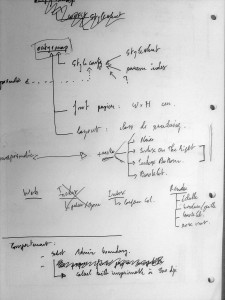We’re early in the morning of day 3 of this MapOSMatic hackfest, everybody is still asleep, so it’s time to do a little wrap-up on what has been done yesterday :
- Maxime and David have continued their work on refactoring the OCitySMap module and extending it to support the new level of map customization that we will offer. So far, the map generation is working again, together with the overlayed grid, with a much, much better Python code, that will hopefully allow us and other contributors, to add more features more easily than in the past. Today, they will continue their refactoring work with the street index generation.
- Gaël has continued and completed his work on the slippy map user experience improvements. The user now draws a rectangle to define the area to be rendered, and we immediately check whether the area is too big to be rendered by MapOSMatic.
- Éric has continued his experimentation of the ReportLab PDF library and its Platypus page layout engine, but finally came to the conclusion that while the automatic page layout engine is nice, it doesn’t provide enough control on the layout to generate a street index similar to the one we’re doing today.
- Pierre has worked on different small but important improvements:
- in the page corresponding to a particular rendering, add a link to the corresponding location in OpenStreetMap so that an user can easily check the current status of a particular area
- in the results provided by our Nominatim proxy, add information about the size of each administrative boundary. This will allow us to no longer limit the selection of administrative boundaries to level 8 boundaries while still preventing the user from rendering too large areas.
- I’ve worked on finishing the Map Creation Wizard that allows to select the different parameters for a map. It is now feature-complete, the code has been cleaned up, even though it still need some more polishing, especially on the presentation side, which will done later by Maxime, our CSS expert.
Last, but not least, the import of the planet database has completed on our new server that should start hosting the official MapOSMatic.org website in a couple of days or weeks. With a better CPU, two times the amount of RAM and four times the amount of disk of the previous server, it should provide a more scalable hosting solution for the coming months.
Today, work will continue with a first integration of the different improvements, the rest of the OCitySMap refactoring, experiments on Cairo for the booklet generation, improvements on the street index generation, experiments on rendering Wikipedia pages, final details on the wizard, and more.
Stay tuned for tomorrow updates !

